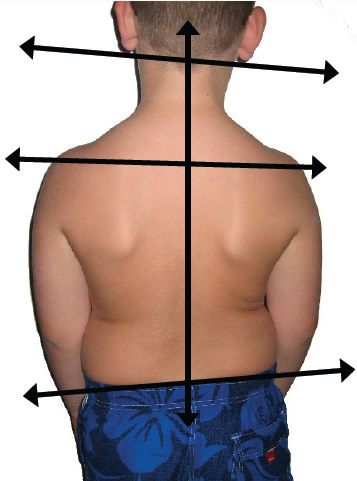
Perhaps you remember your parents telling you to sit up straight and now you’ve found yourself telling your children the same thing. Is this just a right of passage from childhood to adulthood, or is there something more to this thing called posture?
What is Posture?
Posture is defined as the position of the body or the position of several parts of the body with respect to each other for a particular purpose. Posture is not, regardless of what we have been led to believe, simply a matter of sitting or standing up straight. Instead, it is the actual and proper alignment of the parts of the body in relation to the spine, and the proper use of the body at all times.
Posture and the Young Child
As soon as a child begins to stand upright, you can begin to look for signs of improper posture. Signs of head, shoulder or hip tilt can be seen as soon as a child is weight bearing.
Although this may seem early for a child to have misalignments to their spine, birth injuries and falls taken when learning to walk can already begin to affect their posture.
Posture and the Pre-Adolescent
With a child that is between the ages of seven and ten, misalignments to the spine are more than likely due to minor falls and injuries associated with certain activities. These typically include soccer or other sports, as well as injuries sustained on playground equipment or trampolines. It is also with this age group that we begin to see a lot of time spent watching TV, and in many instances, the child will be lying on their stomach; another habit that can cause postural issues.
Children in this age group are frequently seen playing video games and, with both handheld games and console games with a controller, the child will be sitting in a head down position or with their shoulders hunched which is equally troublesome to a developing spine.
In response to these causalities, the body will typically begin to adapt to the improper alignment and cause postural deviations that you can see. These can include a tilting of the head, which may reflect a misalignment in the neck. A shoulder tilt might indicate a mid-back issue, and a tilted hip can mean a misalignment of the hip, sacrum or lower back. If a child’s foot is turned out or in, this can indicate a problem in the pelvic area.
These different deviations are “signals” of an underlying problem but generally, there won’t be symptoms such as pain or discomfort related to these issues.
Posture and the Pre-Teen and Teen
Many of the same issues faced by the pre-adolescent are simply compounded by the additional strains of the life of a pre-teen or teenager. The most obvious issue is backpacks, which concerns strain to the spine, especially when loaded or carried improperly. Although we can’t ignore the ergonomics of texting with the head bent down or too much time spent on the computer with shoulders hunched and the head forward.

The body will typically begin to adapt to the improper alignment and cause postural deviations.”
With your pre-teen and teen, you’ll find the same postural deviations of the pre-adolescent as signals of the problem, but you may find that the teen will actually show symptoms more visibly. These can include neck and shoulder tension, headaches and, with teenage girls, menstruation problems.
Additionally, with teenagers, you may see the shoulders begin to roll forward and, when this happens, the head moves forward as well. Consider that the head is like a 6-10 pound bowling ball, and you’ll see that this can lead to a tremendous amount of strain to the neck and shoulders. A good rule of thumb when gauging your teen’s posture is, that the ear lobes should be directly over the shoulders.
If you ask your teenager to stand up straight and they complain of any discomfort or pain, this could be a sign of a problem that should be checked by a Family Wellness Chiropractor.
Posture and the Adult
Postural deviations that begin in childhood, and are left undetected or uncorrected, will generally lead to bigger problems when those children and teens become adults. It is in adulthood that the signals of head tilt, shoulder tilt, hip tilt and head moved-forward begin to develop symptoms of discomfort and pain. Typically this is seen in chronic neck and back pain Signals of a severe postural problem for the senior adult are the shoulder hump or the hunched- over posture. The underlying concern of this posture is a lack of balance,
which leads to falls and can result in more serious injury to the skeleton.
In Summary
Clearly the best defense against future problems is early detection. The earlier you catch the problem, the better chance that the problem can be corrected avoiding future complications. That’s why it’s important to have your children and teens screened.
Your Doctor of Chiropractic is the only healthcare professional that is trained in the early detection and correction of spinal misalignments, postural deviations and Vertebral Subluxation Complex.

Four Steps to Performing a Postural Exam
Step one – look at bottom of ears; if one is higher than the other, this is head tilt and a sign of a possible neck misalignment.
Step two – look at the shoulders; they should be level, if they are not, shoulder tilt is a sign of a possible mid-back issue.
Step three – place your hands on the wing bones or scapula; if one is moved toward you more than the other, this could be the sign of a mid back issue.
Step four – place yourhands on your child’s hips; if one hand is higher than the other, this is hip tilt and can be an indicator of a misalignment of the hip, sacrum or lower back.

Side View Analysis
When looking at a side view there are two signs of possible postural deviations or spinal misalignments. The first sign is the ear lobes; are they directly over the shoulder or slightly forward?
The second sign of a potential problem are shoulders hunched or rolled forward. If you see either of these signs itis wise to contact your Family Wellness Chiropractor.
Dr. Gray is dedicated to providing you with the absolute best in family wellness care. So take a moment today to discuss with your Family Wellness Chiropractor any concerns you may have regarding your family’s overall health and wellness.
